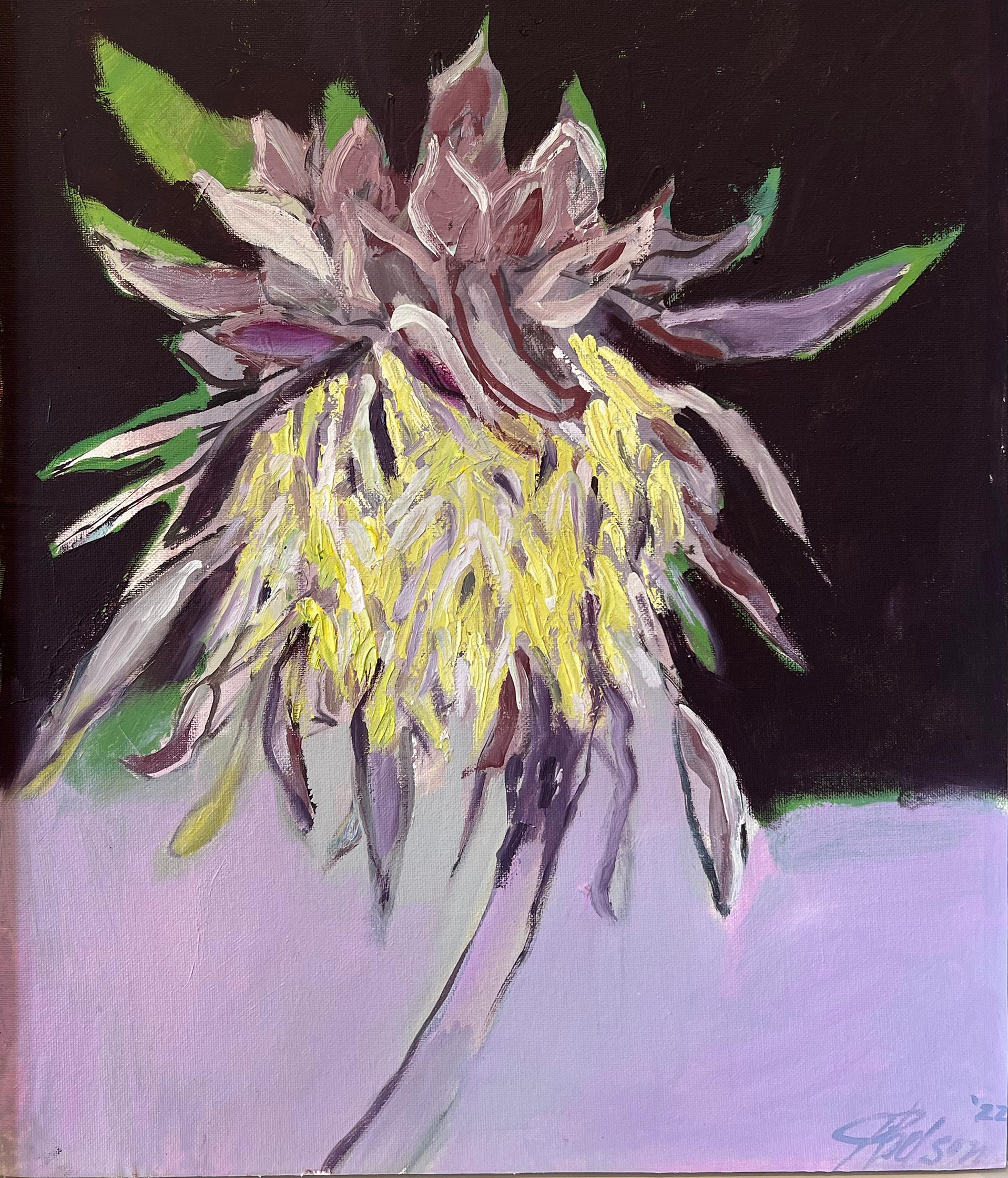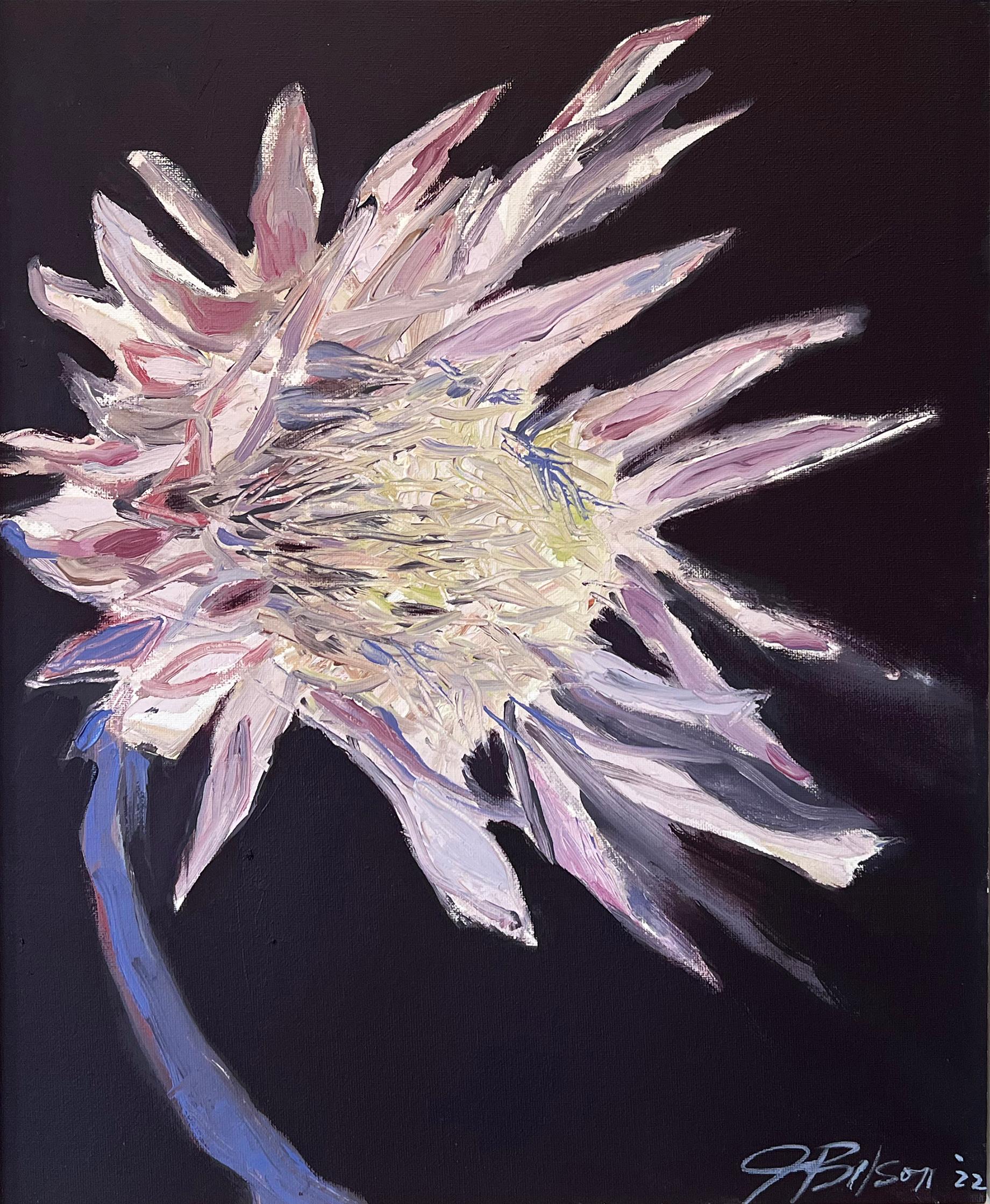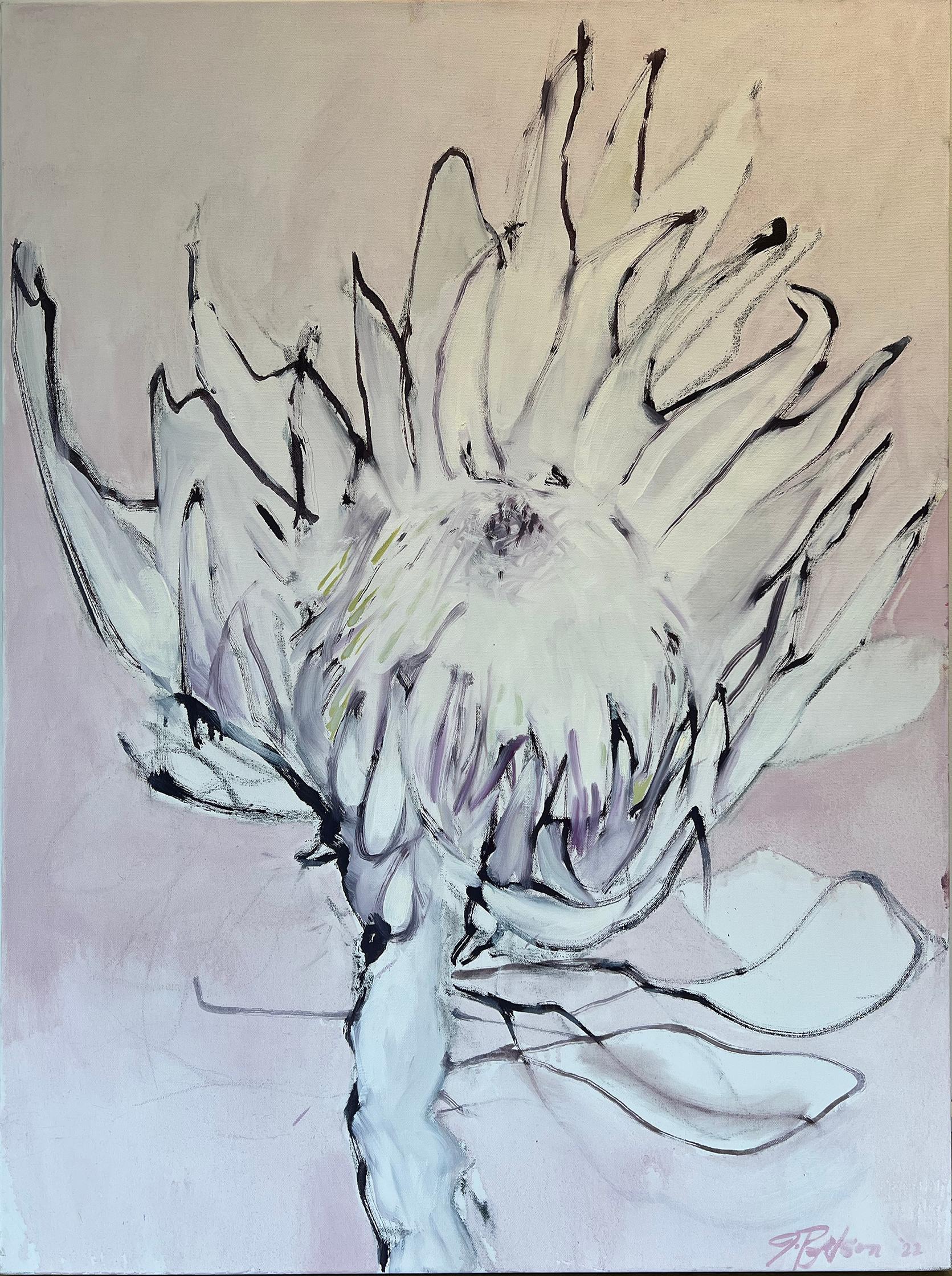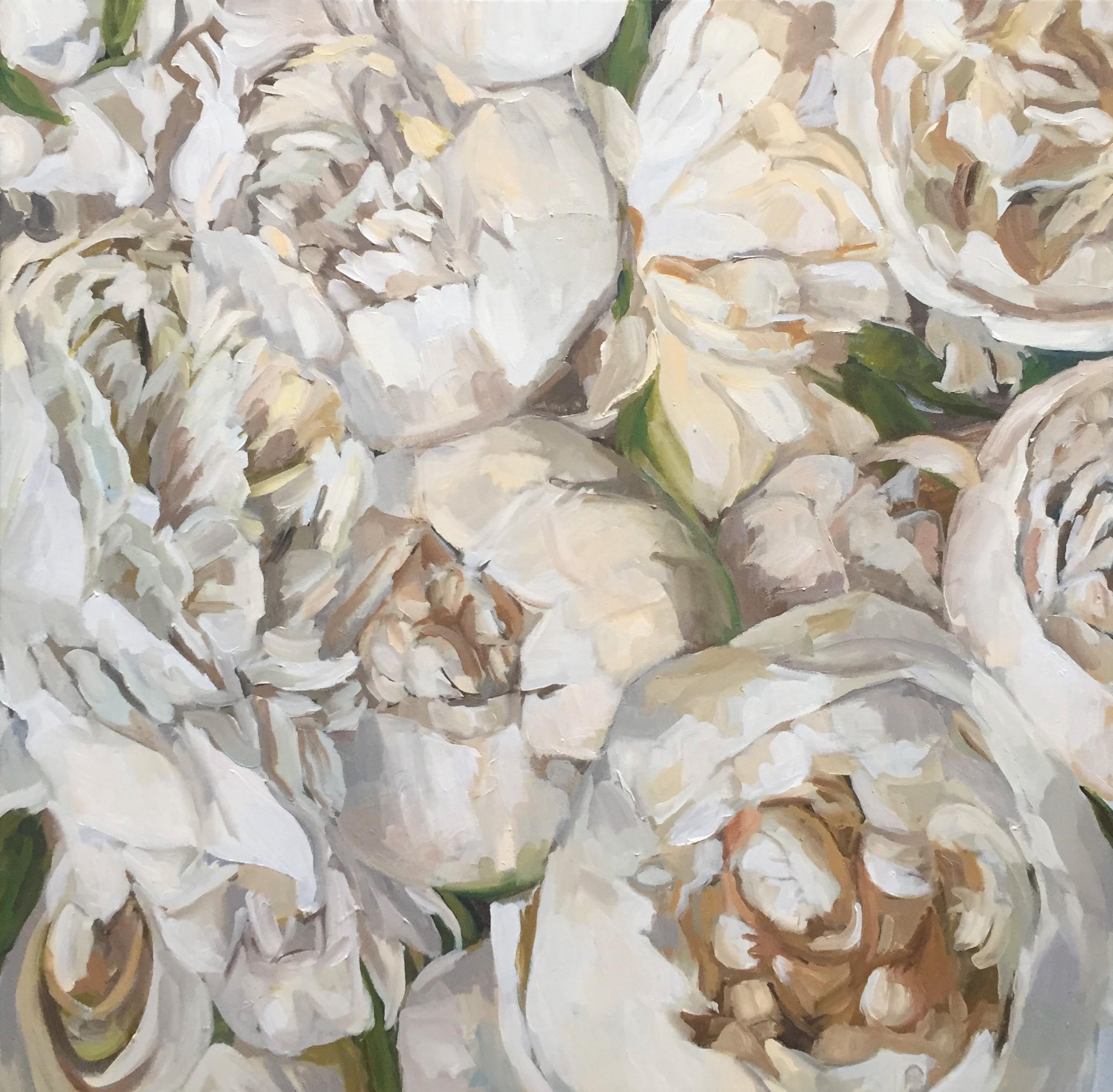Items Similar to A Still Life of Begonias
Want more images or videos?
Request additional images or videos from the seller
1 of 10
James Stuart ParkA Still Life of Begoniascirca 1900
circa 1900
About the Item
James Stuart Park
Scottish School
Oil Canvas
Picture Size: 30 x 24" (76 x 60cm)
Outside Frame Size: 40 x 34" (102 x 86cm)
Park lived from 1862 – 1933 and was born in Kidderminster. He lived in Glasgow from 1883 and later moved to Kilmarnock in 1904.
He studied at the Glasgow School of Art and then in Paris, at the Académie Julian with Gustave Boulanger and Jules-Joseph Lefebvre, and at the Ecole des Beaux-Arts, with Ferrnand Cormon. He started out as a portraitist but, finding it difficult to support himself, he turned to flower pieces. Painting carefully arranged bouquets of roses, lilies, orchids and azaleas he developed a very individual technique, using thick and rapid strokes against a very dark background, suggesting, rather than defining, the texture and colour of flowers.
His radically simplified style, in which the petals and flowerheads are almost abstracted and painted in rapid, cursive strokes, found favour with the Glasgow Boys and – although he was unique amongst them as almost solely a painter of flowers – he became a member of the group, along with his peers: Joseph Crawhall, E.A. Walton, Harrington Mann, George Pirie, &c (the last two of whom had also trained with Boulanger and Lefebvre).
Park worked only in Scotland, exhibiting regularly at the RSA and Glasgow Institute and exhibited rarely in England. His work became fashionable, particularly in the West of Scotland, and he was soon able to charge fairly high prices for his rapidly executed paintings.
He exhibited with the Glasgow Boys at the Royal Scottish Academy and the Royal Glasgow Institute, and worked from a studio in Glasgow until 1896, when he moved back to his home region of Kilmarnock.
The Glasgow Boys were profoundly influenced by the work of Bastien-Lepage: its naturalism, light key, and figures placed in a shallow foreground, which led them to Japanese prints with their similar use of space, and to the equally influential work of Whistler. The same interests can be seen in Stuart Park’s portraits (his Self-portrait, A gipsy maid, c.1890-95, and Dr John MacIntyre, c.1904), and in his earlier flower pieces, which are notable for their observation, their use of flat tones, shallow space or asymmetric compositions. His best work was produced in the 1880s and -90s, but even his more formulaic later work, with its undifferentiated flowers floating on a black ground, remained extremely popular with his clients. He was an accomplished watercolourist.
Works in public collections include:
Begonias, Green & yellow roses, Roses, The Hunterian Museum & Art Gallery, Glasgow; Self-portrait, Woman & roses, Red & white roses, Red & white geraniums, The Dick Institute, Kilmarnock; Orchids, Pansies, Daffodils, Dr John MacIntyre, Glasgow Museums Resource Centre.
Other examples of his work are to be found in the collection of the Lillie Art Gallery, Milngavie and Dundee City Art Galleries and Museums.
He is referred to as Stuart Park.
He died at Kilmarnock, aged 71.
He has exhibited at:
Baillie Gallery X 6
Connell and Sons Gallery X 4
Grosvenor Gallery X 2
Glasgow Institute of Fine Arts X 116
International Society X 11
Walker Art Gallery X 27
Manchester City Art Gallery X 2
Royal Academy X 1
Royal Scottish Academy X29
Royal Scottish Society of Painters in Water Colours X 2
- Creator:James Stuart Park (1862 - 1933, Scottish)
- Creation Year:circa 1900
- Dimensions:Height: 40 in (101.6 cm)Width: 34 in (86.36 cm)Depth: 4 in (10.16 cm)
- Medium:
- Movement & Style:
- Period:
- Condition:
- Gallery Location:St. Albans, GB
- Reference Number:1stDibs: LU2469213116032
About the Seller
5.0
Gold Seller
These expertly vetted sellers are highly rated and consistently exceed customer expectations.
Established in 1965
1stDibs seller since 2023
19 sales on 1stDibs
Typical response time: 2 hours
- ShippingRetrieving quote...Ships From: St. Albans, United Kingdom
- Return PolicyA return for this item may be initiated within 7 days of delivery.
More From This SellerView All
- A Still Life of FlowersBy Dorothea SharpLocated in St. Albans, GBA wonderful example of Dorothea Sharp's still lifes. Full of vibrancy and effervescence this painting ,with her classic broad brush strokes, show her talent at its best. It is in a w...Category
Early 20th Century Impressionist Still-life Paintings
MaterialsOil
- A Still Life of Figs and MelonLocated in St. Albans, GBJean Baptiste Olive This premiere piece shows his work and influence which he had with Antoine Vollon. It is in its museum quality gold leaf frame. The piece has been exhibited in many shows with the exhibition labels on the reverse testimony. Artwork Size: 22 x 18" (56 x 46cm) Artwork Size with Frame: 31 x 27" (79 x 69cm) Free Shipping French, 1848-1936 Jean-Baptiste Olive was undoubtedly one of the greatest masters of the Marseille school at the end of the 19th century, along with Paul Guigou...Category
Late 19th Century Impressionist Still-life Paintings
MaterialsOil
- Un Bouquet de Fleurs SpectaculaireBy Marcel DyfLocated in St. Albans, GBMarcel DYF 1899 - 1985 Oil on canvas Canvas Size 28 x 23" (72 x 60cm) Outside Frame Size: 36 x 31" (92 x 80cm) Free Shipping Dyf’s family lived in Paris, but he spent his childhood holidays in Normandy at Ault, Deauville, and Trouville. The artistic climate to which he was exposed in Paris and in Normandy was crucial during his youth, as innovative ideas and new thinking, born of the Impressionist and Post-Impressionist movements, formed ever widening circles of influence in Europe. Swept up in the atmosphere, Dyf decided in his early twenties to give up his career in engineering and become an artist. He moved to Arles in 1922 to pursue his calling and he kept a studio there until 1942. He had little formal artistic training but owed much of his inspiration to the great masters of the past such as Rembrandt, whom he particularly admired, Vermeer and Tiepolo. In Provence, challenged by a new range of colours and light, by new landscapes and images and under the same intense sky that lent its brilliance to Van Gogh’s art, Dyf graduated from painter to artist. Whilst living in Arles, Dyf was commissioned to paint a number of large historical and decorative works, mostly frescoes, in the town halls of Saint Martin-de-Crau and Les Saintes Maries-de-la-Mer, in Arles, in the Museon Arlaten and in the dining hall of the Collège Ampère. He also designed windows for the church of Saint Louis in Marseille. In 1935 Dyf took on Maximilien Luce’s old studio in the Avenue du Maine on the left bank. His partial return to Paris meant that he could work with many whose names became renowned for their highly original contributions to art, music, and literature. Paris hummed with creative vitality in the 1930s and Dyf was both participant and recipient in the atmosphere. Paris was shattered by the invasion of 1940. Like many others, Dyf left the city and returned to Arles, but he quickly had to abandon his home in the south and he took to the Maquis, entering the Résistance in Corrèze and the Dordogne. After the Liberation he returned to Arles to find the studio reduced to rubble in the fighting. He retreated, heavy-hearted, to Paris but the pull of the Midi was deep-rooted, so in time he returned and made a new base in Saint Paul-de-Vence. Thereafter he divided his time between Paris and the south. His pictures began to sell through galleries in Cannes, Nice, Marseille and Strasbourg. In Paris he exhibited and sold his paintings through the Salon d’Automne, the Salon des Tuileries and the Salon des Artistes Français. In the first half of the 50s Dyf worked in Paris throughout the winter and spent the summer in Cannes, where he set up a studio-gallery and established a regular following among American visitors to the Riviera. In 1955 the first paintings were bought from Dyf by Frost & Reed to be sold in London, thus heralding the formation of a remarkable and enduring relationship between artist and gallery. In the summer of 1954, Dyf met Claudine Godat. Aged 19, she was thirty-six years younger than Dyf and with her long fair hair, clear skin, vivacity and patience, she was what the artist felt to be his perfect model. It was simply love at first sight. There was an instant rapport between them and her arrival in his life acted as a catalyst, bringing Dyf’s art forward to the threshold of its most mature phase. In 1956, they married and bought a 16th century hunting lodge at Bois d’Arcy, near Versailles. This became their main home, but each winter they returned to Provence on painting trips, staying in Saint-Rémy or in the small village of Eygalières. The olive trees, the cane windbreaks and the grey-white crags of the Alpilles provided countless motifs for Dyf’s paintings of Provence, and his artistic and emotional attachment to the area endured to the end of his life. In 1960, at Claudine’s insistence, they first visited Brittany. They explored widely and finally came upon the Golfe du Morbihan. Dyf was enchanted with this remote, beautiful region. He immediately saw the potential for new subjects, in the still waters of the huge lagoon surrounded by rolling fields of wheat and tiny clusters of slate-roofed cottages, and he knew he must return to paint there. From that time on the seasons of the year followed the same pattern: autumn was spent at home near Versailles and in the late autumn or early spring Dyf and Claudine drove south and spent six or eight weeks in Provence. In May they left for Brittany, where they spent the summer in a house they had bought opposite the church in the village of Arzon. Two or three times a year Frost & Reed would visit Dyf and buy all the best of his works for their stock. Dyf could never work in an empty studio, he said that it deadens an artist’s inspiration, so immediately the paintings had left for London, he and Claudine would set off to the west or to the south in search of new inspiration. This annual round having been established, there followed many years of great fulfilment. The artist, free from the burden of running the more mundane side of his life, was now able to devote all his time to painting and through Frost & Reed, his sole world agent, he was guaranteed an outlet for his work. To watch Dyf paint was entrancing. Even as an old man, he would stand rather than sit before the easel, working with extraordinary vigour and intense concentration. His palette was a rainbow of fresh colours and his hand continually darted back and forth from the canvas. At intervals he would step back or consider briefly another picture before returning to the easel, his eye refreshed. Usually he sketched straight onto the canvas, which he set up on his travelling easel...Category
1960s Impressionist Still-life Paintings
MaterialsOil
- A Still Life of RosesLocated in St. Albans, GBKees TERLOW/ TERLOUW Panel Size: 24 x 48" (61 x 122cm) Outside Frame Size: 30 x 54" (76 x 137cm) Oil on panel A signature style piece with bold, beautifully painted roses and his ...Category
Early 20th Century Impressionist Still-life Paintings
MaterialsOil
- A Still Life of Roses in a Ceramic Vase. An oil on canvasBy Marcel DyfLocated in St. Albans, GBMarcel DYF 1899 - 1985 This piece has been confirmed by Claudine Dyf Picture Size: 18 x 22" (48 x 55cm) Outside Frame Size: 25 x 29" (63 x 73cm) A highly desirable still life with...Category
Mid-20th Century Impressionist Still-life Paintings
MaterialsOil
- A Still Life of the Madonna, Flowers and a China PotLocated in St. Albans, GBHenri Lucien Joseph BURON This is potentially Henri Buron's premier work of art. It was exhibited in the Salon des Artistes Française in 1934 having been painted in 1933. The revers...Category
1930s Impressionist Still-life Paintings
MaterialsOil
You May Also Like
- A Pair of Kings, No. 1Located in Washington Depot,, CToil on canvasCategory
2010s Impressionist Still-life Paintings
MaterialsCanvas, Oil
- A Pair of Kings, No. 2Located in Washington Depot,, CToil on canvasCategory
2010s Impressionist Still-life Paintings
MaterialsCanvas, Oil
- Love of ProteaLocated in Washington Depot,, CToil on canvasCategory
2010s Impressionist Still-life Paintings
MaterialsCanvas, Oil
- Impressionist:, School of Pierre Bonnard, signed oil 1950'sLocated in Frome, SomersetA fine large oil, school of Pierre Bonnard. circa 1950's. oil on canvas 55cmx75cm The original wood and textured gesso frame 72cmx92cm Titled 'On the Window Sill'. Indistinctly sign...Category
1930s Impressionist Still-life Paintings
MaterialsOil
- White Peonies from Covent GardenBy Katharine RoweLocated in London, GBThis was the flower artist Katherine Rowe had in her wedding bouquet and so they have always had a special place in my heart. Despite being 'white' there is hardly any actual pure white in the painting but multiple blues and yellows and greens. Katharine Rowe is an English painter she graduated in Fine Art and History of Art at the University of Edinburgh in 1999 and spent a year studying at Université de la Sorbonne, Paris. Having spent a decade working in advertising Katharine felt the increasing need to be out of the office and with her paintbrush. The past 9 years have been dedicated to just that. Katharine is strongly motivated by colour and she often spends up to an hour mixing and preparing paints before turning to the canvas. Katharine is always inspired by her surroundings from the varied landscapes of...Category
2010s Impressionist Still-life Paintings
MaterialsOil
- A Still Life of flowers and fruit on a tableLocated in Brookville, NYThis painting is signed in the upper right corner "Dolya" which appears to be a word, not a name, it could refer to a village in Svatove Raion Ukraine. We have never been successful...Category
Mid-20th Century American Impressionist Still-life Paintings
MaterialsOil
Recently Viewed
View AllMore Ways To Browse
Art Resource Group
Trajans Forum And Markets
Vintage Barnard College
1963 Painting By Morris Katz
Air Jordan 1 Chicago
American Optical 12k
Bernard Ro
Du Male Edouard
Joachim Wtewael
Norm Siegel
Rafael Zabaleta
Retrato Azul
African Male Pillow
Chanel Club Monaco
Eugene Edward Speicher
Gary Schildt
Greg Robinson
Halsey Ives




